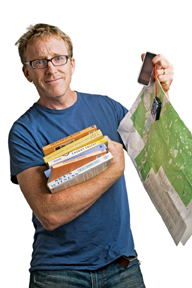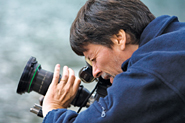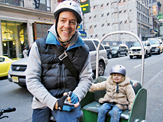sierraclub.org - sierra magazine - September/October 2009 - mixed media


Mixed Media | Deep Thoughts and Oddball Interpretations
The Great American Read Trip | Earth Beat: A Walk in the Park With Ken Burns | Year of Living Deliberately
The Great American Read Trip:
Resources for your next big adventure
 I love the way the Internet anticipates one's curiosity, and I bet you know the feeling: Gee, I'd love a tip or two on where to go trail running in Rocky Mountain National Park. I guess I could always try Googling... Wow, look at this! An entire Web site devoted to people posting favorite trail runs all over the country. This is amazing!
I love the way the Internet anticipates one's curiosity, and I bet you know the feeling: Gee, I'd love a tip or two on where to go trail running in Rocky Mountain National Park. I guess I could always try Googling... Wow, look at this! An entire Web site devoted to people posting favorite trail runs all over the country. This is amazing!
You could replace "trail running" with almost any other human activity--quilting, skydiving, studying the Talmud--and you'd find a social-networking Web site where like-minded folks are already sharing information. That trail running site, for example, is Trailrunner.com. In decades past I would have been utterly clueless about how to find a perfect loop in a remote wilderness area, but it took me no more than a few keystrokes to unearth a helpful post about the Lawn Lake Trail, in Estes Park, Colorado, "winding through an evergreen forest along the Roaring River."
I do a little rock climbing too, and I am astounded by how Supertopo.com has gone from a puny project that couldn't add much to my library of climbing guidebooks to an invaluable resource where climbers can ogle photo galleries like "Classic Climbs of the Colorado Plateau," get the skinny on "good first desert climbs," and follow esoteric discussions on Kansas bouldering.
For watersports types, Paddling.net is equally useful, and the smartphone revolution only adds to the power of all this stuff. You can pull over in Moab, Utah--kayak and mountain bike on the roof rack, hiking boots in the trunk--and browse expedition options on the Internet in the time it takes your friend to grab a smoothie at the local juice bar. (And while you're at it, you might as well download Packing Pro and Topo Maps, two awesomely useful new iPhone apps guaranteed to make sure you never again forget your sleeping bag or the directions to a trailhead.)
To be fair, wholesale dissemination of information does change the experience--it's not quite the same when the unknown is so well known. And the American will to wilderness--that core cultural impulse making us all itch for at least one outdoor adventure a year--does have roots in early narratives that dwell on precisely that, the unknown. From Jedediah Smith to Henry Thoreau to Laura Ingalls Wilder, Americans have invented and reinvented themselves by encountering landscapes they could at least sort of convince themselves that nobody had encountered before. (For a sweeping intellectual history of this effect, check out Roderick Nash's indispensable old warhorse Wilderness and the American Mind, first published in 1967; a fourth edition was released by Yale University Press in 2001.)
Many of our finest outdoor writers still mine those old veins with beautiful results, from C. L. Rawlins's gorgeous 1993 memoir Sky's Witness: A Year in the Wind River Range (Henry Holt) to Robert Thorson's just-published Beyond Walden: The Hidden History of America's Kettle Lakes and Ponds (Walker & Company). Others, like Langdon Cook's Fat of the Land: Adventures of a 21st Century Forager (Skipstone Press, 2009), demonstrate that we Americans have only gotten, well, hungrier when it comes to the old explorer ideals.
But there's a brand-new crop of wilderness narratives, and they prove that technology ain't the only thing getting an update. Today's female outdoor writers and filmmakers and podcasters own these grand environmental battles and grand expeditions as much as any male. Take, for example, Kelly Duane's documentary film, Monumental: David Brower's Fight for Wild America (Loteria Films, 2000). Now sure, Kelly's my sister, but trust me, that actually makes it harder for me to admit the obvious: This is an entertaining primer on the great conservation fights that protected many of the places we now take for granted. (It has a heck of a good soundtrack too, with lots of killer alternative rock you'll want to find on iTunes, especially from a band called the Fruit Bats.)
In Steph Davis's High Infatuation: A Climber's Guide to Love and Gravity (Mountaineers Books, 2008), the author roams the world, scaling bad-ass peaks in every national park and on every continent, and feels no need to marvel that her grandmothers probably didn't have anything like that freedom. Chasing Waves: A Surfer's Tale of Obsessive Wandering (Mountaineers Books, 2009) is equally notable for the word left out of the subtitle: A Woman Surfer's Tale of Obsessive Wandering. These journeys are equal opportunity now, and hallelujah!
Give yourself a serious jolt of awe and envy by checking out dispatches from the round-the-world solo-sailboat journey of surfer and fisherman Liz Clark at swellvoyage.com. Her missives show her mind-blowing blend of guts, calm, and grace. I seriously hope my own daughters feel equally at home exploring the natural world. --Daniel Duane
ON THE WEB Find hiking, biking, and paddling recommendations and share your own at the Sierra Club's new online resource: trails.sierraclub.org.
An otter--doglike and dogsized little mustelid--backstroked nearby with awfully anthropomorphic repose. He had a rock on his belly and kept slamming a mussel shell down on it, then gnawing at the crack; though doubtless cold and fraught with danger, the otter's life was quite a recommendation for the neighborhood. Once shivering and tired, I rode an already-broken wave to get back in. When it lifted up over the rock shelf, I leaned back and stumbled onto the reef, my equilibrium still adjusted to a surging liquid. The very low tide had exposed mossy reefs and pools of anemones, and I walked slipping and splashing among slimy boulders hung with limp sea grass. Sat on a shelf of shale and waited for Skinny, got this funny feeling about the whole place, like I didn't see myself surfing anywhere else any time soon. As we changed, Skinny said something about preferring high performance waves, how he found this reef a little mushburgery and lumpy. Most of the guys he surfed with, apparently, outright refused to come here; he'd only agreed because he thought it might be nice for me to get away from town. As he spoke, the day flushed broad and bright across the water, and the sky's open blue shone in little puddles; I didn't tell Skinny, but I really couldn't believe the whole thing, the whole gift of California at the end of the twentieth century, alive and available in a little place by a little highway with no sign.
Excerpt from Daniel Duane's Caught Inside (North Point Press, 1996).
Earth Beat: A Walk in the Park With Ken Burns
Audio! Listen to the full interview.
 Nice work if you can get it--being Ken Burns, that is, and spending ten years making a documentary called The National Parks: America's Best Idea. The six-part, 12-hour series, which airs on PBS stations starting September 27, joins The Civil War, Baseball, Jazz, and many other Burns treatments of iconic American subjects.
Nice work if you can get it--being Ken Burns, that is, and spending ten years making a documentary called The National Parks: America's Best Idea. The six-part, 12-hour series, which airs on PBS stations starting September 27, joins The Civil War, Baseball, Jazz, and many other Burns treatments of iconic American subjects.
How does your new series seek to stretch the conventional view of national parks?
Too often our history is a sanitized "Morning in America" version that misses the more interesting, complicated, and sometimes tragic stories. In the case of the national parks, for the first time in human history land was set aside not for kings or noblemen or the very rich but for everybody and for all time. In our series you get to know some of the familiar figures--John Muir, Theodore Roosevelt, John D. Rockefeller Jr. But you'll also meet 45 people who are less well known, who are black and white and brown and yellow and red and male and female and rich and poor, who fell in love with some particular piece of land, and who worked for their entire lives to preserve it for people they didn't know. Their story is what we try to tell.
That's a struggle the Sierra Club is very familiar with.
The Sierra Club is born in our first episode and becomes an important part of the story that we tell. Carl Pope comes into our film several times at really critical moments to help us make some important connections.
You and I have both spent a lot of time in national parks. But we're middle-class white guys. What keeps people of color out of national parks?
We ask that same, very important question of Hispanic Americans and Asian Americans and others who don't yet feel the ownership in the parks. But when African American kids learn that the first protectors of Yosemite and Sequoia were the celebrated buffalo soldiers and that they were telling people what they could and could not do in a decade when more African Americans were lynched than at any other time in our history, that's a great story [see "Gloryland," page 55].
What place ought to be a national park that isn't?
I would like to see Grand Staircase-Escalante in southern Utah elevated to national park status. It would finish off that magnificent trail of Utah parks, from Zion to Dinosaur.
But our notions are continually expanding. In the beginning, our conception of a national park was just obvious natural scenery. And then we got into cultural artifacts, habitats, diverse ecological places like the Everglades, which even the Park Service referred to as a "dismal swamp." Then we started setting aside battlefields and other historic sites. We have wild and scenic rivers; we have trails, seashores, and recreation areas. We have more complicated places: We've set aside plantations and slave houses; we've set aside sites of Indian massacres; we have Manzanar, site of the shameful internment of Japanese Americans during World War II. We are continually enlarging our notion of what a national park is.
What do you make of the Imax phenomenon, where people go to national parks and experience them through film rather than directly?
We live in a virtual age, where everyone is addicted to the handheld PDA, to the TV, to the iPod. That's not a substitute for real life. The parks remain places where you can look and see things just as John Muir, your founder, saw them 150 years ago, or as the ancestors of the Ahwahneechee saw them 8,000 years ago. That's spectacular.
People sometimes worry that the national parks are being "loved to death." Are you contributing to that?
We're hoping that every superintendent of every national park unit will be angry at us because they got more people than they know what to do with. These parks need a constituency; they need people who are actively engaged in letting their representatives know how valuable they are to our national well-being. So the more people the better. It may mean we'll have a monorail in that glorious figure eight in Yellowstone, I don't know. We do know that the popularity of Zion forced everyone to park and take buses, and Zion is still a hugely popular park.
What is your environmental vice?
I am a walking red-light district of environmental vice. I drink water out of plastic bottles; I drive cars driven by internal combustion engines; I live in an old house built in the 1820s whose windows and doors must leak ridiculously; I still have incandescent lightbulbs. I have learned to turn the tap off while I'm brushing my teeth, but it's a long way to go. You're looking at a sinner who's seeking redemption.
Well, shame on you, Ken Burns, but thanks for talking to us.
—interview by Paul Rauber
Year of Living Deliberately
 Thoreau sought simplicity in the woods; Colin Beavan tried Manhattan. Determined to live a carbon-free year, the writer cajoled his wife, Michelle Conlin, and two-year-old daughter, Isabella, into joining Daddy's ascetic experiment, documented in all its toilet-paper-less and coffee-bean-free glory in the film No Impact Man. What might sound like a do-good treatise is enlivened and transformed by the evolving skepticism of latte-sipping, Prada-clad Conlin, a writer for BusinessWeek.
Thoreau sought simplicity in the woods; Colin Beavan tried Manhattan. Determined to live a carbon-free year, the writer cajoled his wife, Michelle Conlin, and two-year-old daughter, Isabella, into joining Daddy's ascetic experiment, documented in all its toilet-paper-less and coffee-bean-free glory in the film No Impact Man. What might sound like a do-good treatise is enlivened and transformed by the evolving skepticism of latte-sipping, Prada-clad Conlin, a writer for BusinessWeek.
In theaters in September, No Impact Man will air on TV in 2010 as part of eco-lifestyle network Planet Green's new documentary series, Reel Impact. There's also a companion book (from Farrar, Straus & Giroux) and an ongoing blog (noimpactman.com), so No Impact Man should have, er, plenty of impact. —Reed McManus
Photos, from top: PBS/Jason Savage, Justin Schein; used with permission